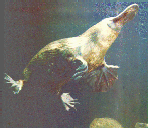| Recently, scientists have conducted
a biochemical characterization of platypus venom and have discovered it
to be a complex mixture of proteins and non-protein substances not usually
found in animal venom. Interestingly, scientists identified the presence
of a 39 amino acid C-type natriuretic peptide (CNP-39) in platypus venom.
C-type natriuetic peptides are distributed widely throughout the mammalian
body. These peptides are found in the central nervous system, the kidneys,
the lower part of the gastrointestinal tract, and endothelial cells (de
Plater et al., 1998). Although the definite physiological function of CNP
is not known, evidence suggests that C-type natriuretic peptides have a
pathological role in cytokine associated disorders, septic shock, and renal
failure (Kourie, 1999).
Studies show that CNP-39 from
platypus venom causes the relaxation of rat uterus cells, histamine releases
from rat mast cells, and pronounced edema (swelling) in the rat paw (Rat
Uterus, 1998). Kourie et al. (1999) have shown that CNP-39 triggers relaxation
of rat uterus by increasing cGMP, an intracellular signaling molecule,
which regulates, among other things, smooth muscle contraction. High levels
of cGMP lead to muscle relaxation by inhibiting smooth muscle contraction.
Also, CNP-39 promotes histamine release from perotineal mast cells, which
in turn produces vasodilation and increases vascular permeability.
De Plater et al. (1998) believe that these effects may facilitate diffusion
of venom components throughout the body. |



